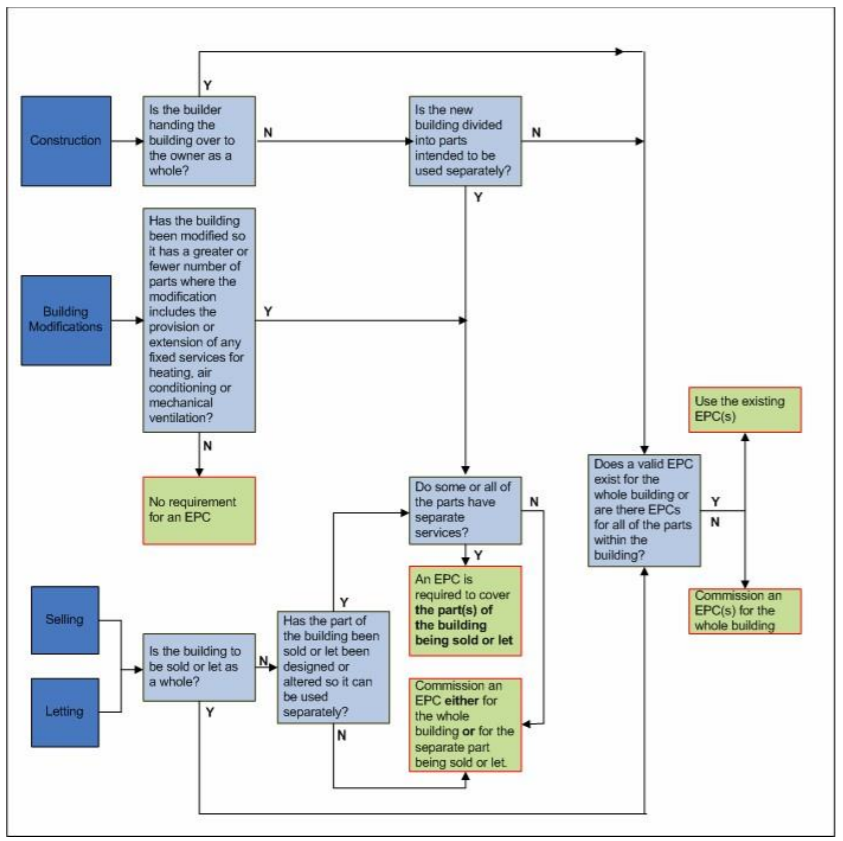In general terms the EPC provided or made available should reflect the accommodation being sold or rented out.
In terms of the requirement for an EPC, buildings can have multiple tenancies, differing lease agreements, various sub-letting arrangements and different uses (e.g. mixed retail, residential and office accommodation). To determine the requirement for an EPC in a building, the following should be considered, although this is not an exhaustive list of the individual circumstances which may arise.
Use of energy to condition the indoor climate and the requirement for an EPC
- fixed services are any part of, or any controls associated with, fixed systems for heating, mechanical ventilation or air conditioning i.e. those services attached to the fabric of the building
- if there is no intention of having fixed services and no ability to include fixed services to condition the indoor climate, then an EPC will not be required
- if a building is to be sold or rented out with fixed services, the EPC for the building should reflect the fixed services actually installed
- if a building is to be sold or rented out without fixed services, but there is an intention that fixed services will be installed, the EPC should be based on the building’s use class under the planning legislation. This applies whether fixed services have ever been installed previously in the building, or whether the building is newly constructed on a ‘shell and core’ basis. For the purposes of producing the EPC, the activity within the building should be specified in line with business activity typical of the use class and the most energy intensive fit-out adopted in line with Part L of the Building Regulations in force when the building was built
- energy used directly for heating or cooling a process is not taken to mean conditioning the indoor climate. Those buildings without any other conditioning would not require an EPC
Use the flowchart below to help determine whether your building requires an EPC:

Plain text version of flowchart
Construction - Question 1. Is the builder handing the building over to the owner as a whole?
Answer 1. Yes: Question 2. Does a valid EPC exist for the whole building or are there EPCs for all parts within the building?
- Answer 2. Yes: Use the existing EPCs. [Flowchart ends]
- Answer 2. No: Commission an EPC(s) for the whole building. [Flowchart ends]
Answer 1. No: Question 3. Is the building divided into parts intended to be used separately?
- Answer 3. Yes: Question 4. Do some or all the parts have separate services?
- Answer 4. Yes: An EPC is required to cover the part(s) of the building being sold or let. [Flowchart ends]
- Answer 4. No: Commission an EPC either for the whole building of for the separate part being sold or let. [Flowchart ends]
- Answer 3. No: Question 5. Does a valid EPC exist for the whole building or are there EPCs for all parts within the building?
- Answer 5. Yes: Use the existing EPCs. [Flowchart ends]
- Answer 5. No: Commission an EPC(s) for the whole building. [Flowchart ends]
Building modifications - Question 1. Has the building been modified so it has a greater or fewer number of parts where the modification includes the provision or extension of any fixed services for heating, air conditioning or mechanical ventilation?
Answer 1. Yes: Question 2. Do some or all the parts have separate services?
- Answer 2. Yes: An EPC is required to cover the part(s) of the building being sold or let. [Flowchart ends]
- Answer 2. No: Commission an EPC either for the whole building of for the separate part being sold or let.
Answer 1. No: No requirement for an EPC. [Flowchart ends]
Selling or letting - Question 1. Is the building to be sold or let as a whole?
Answer 1. Yes: Question 2. Does a valid EPC exist for the whole building or are there EPCs for all parts within the building?
- Answer 2. Yes: Use the existing EPCs. [Flowchart ends]
- Answer 2. No: Commission an EPC(s) for the whole building. [Flowchart ends]
Answer 1. No: Question 3. Has the part of the building being sold or let been designed so it can be used separately?
- Answer 3. Yes: Question 4. Do some or all the parts have separate services?
- Answer 4. Yes: An EPC is required to cover the part(s) of the building being sold or let. [Flowchart ends]
- Answer 4. No: Commission an EPC either for the whole building of for the separate part being sold or let. [Flowchart ends]
- Answer 3. No: Commission an EPC either for the whole building of for the separate part being sold or let. [Flowchart ends]
Examples of a number of common situations and how the regulations may apply can be found in Section 4.
It is the action of selling, renting out or construction that triggers the requirement for an EPC. Therefore, existing occupiers and tenants will not require an EPC unless they sell, assign or sublet their interest in a building on or after the dates the regulatory requirements came into force.
Mike Gordon
Comments